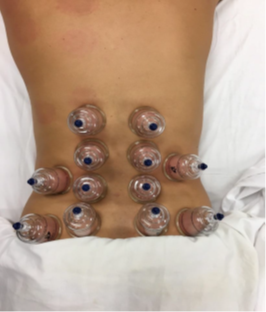By Tim Penner, Registered Massage Therapist
Cupping therapy is a technique using cups applied to the skin to treat an array of illnesses. Used for centuries, its popularity continues to grow as people seek alternative and natural methods for treatment. Cupping stimulates healing by pulling blood to the region being treated. It promotes new blood flow to the area and removes stagnant blood which causes an anti-inflammatory effect by encouraging the body to release white blood cells, platelets, fibroblasts and other healing substances. Cupping is an effective technique to stretch fascia and muscles by helping to separate the different layers of tissue through the use of suction.
Cupping therapy uses cups, made of soft silicone and hard plastic, to suction soft tissue. It is this vacuum effect, or negative pressure that provides a therapeutic result when applied to the skin. Many types of cupping therapy have been developed over the years. At BodyTech Physiotherapy our massage therapist uses 2 different types of cupping techniques: massage cupping and dry cupping. Massage cupping is usually done in a massage therapy treatment in which the cups are applied to the skin and moved around. Dry cupping is slightly different as the cups are applied to the skin and the affected body part is moved around to create a stretching effect.
Is cupping for me?
Massage or dry cupping can be used for many different conditions. The effects on the body include helping decrease stress, encourage relaxation and improve circulation. It can also be used to decrease swelling in certain areas and can help improve respiration when applied to the ribs and chest. When it is used in conjuntion with massage and in specific areas, it helps reduce tension in muscles, and fascial tissue restrictions. The combination of massage and cupping leads to improved range of motion and posture. It can reduce tone in the muscles, help to improve flexibility and aid in reducing fascial adhesions left behind by old injuries. Cupping can help with many conditions such as low back pain, fibromyalgia, whiplash and tendonitis.
Some conditions that can be treated with cupping
- Tendonitis
- Fibromyalgia
- Frozen shoulder
- Low back pain
- Whiplash
- Tension headaches
- Carpal tunnel syndrome
- Plantar fasciitis
- Sprain/strain
- Golfer/tennis elbow
- IT band friction syndrome


Low back pain Iliotibial Band Friction Syndrome
Along with the conditions listed above, cupping also can be beneficial to the people suffering from the effects of Parkinson’s and Multiple Sclerosis, as well as using it to aid in rehabilitation after a major injury or surgery.
The most common side effect of cupping therapy is the bruised appearance that you see after the treatment is completed. The discolouration of the skin is only on the surface of the skin and does not generally cause pain after the massage. The bruised appearance can last for a few days or even up to a week. If significant bruising occurs your therapist will promptly remove the cups and discuss the effects with you.
Overall, cupping therapy can be beneficial to almost everyone. Just like massage, every treatment is specific and individualized to each client and their needs.